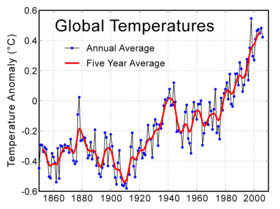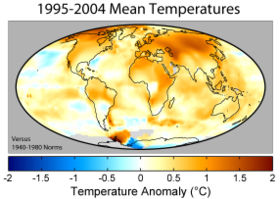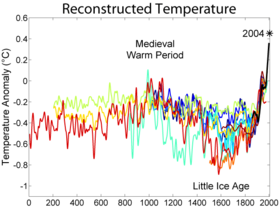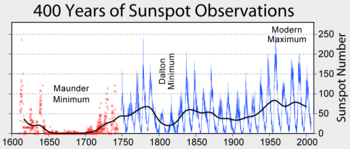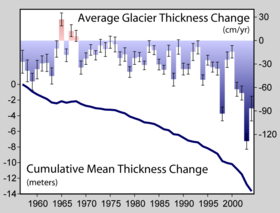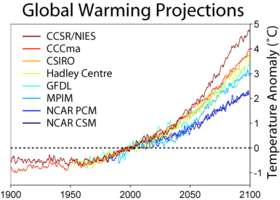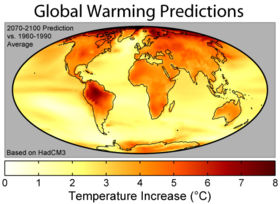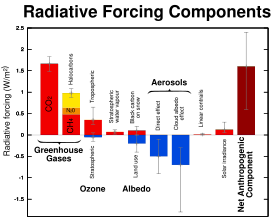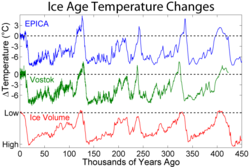Global warming
2007 Schools Wikipedia Selection. Related subjects: Climate and the Weather; Environment
Global warming is the observed increase in the average temperature of the Earth's near surface air and oceans in recent decades and its projected continuation. Models referenced by the Intergovernmental Panel on Climate Change (IPCC) predict that global temperatures are likely to increase by 1.1 to 6.4 °C (2.0 to 11.5 °F) between 1990 and 2100. The uncertainty in this range results from two factors: differing future greenhouse gas emission scenarios, and uncertainties regarding climate sensitivity.
Global average near-surface atmospheric temperature rose 0.74 ± 0.18 ° Celsius (1.3 ± 0.32 ° Fahrenheit) in the last century. The prevailing scientific opinion on climate change is that "most of the observed increase in globally averaged temperatures since the mid-20th century is very likely due to the observed increase in anthropogenic greenhouse gas concentrations," which leads to warming of the surface and lower atmosphere by increasing the greenhouse effect. Greenhouse gases are released by activities such as the burning of fossil fuels, land clearing, and agriculture. Other phenomena such as solar variation and volcanoes have had smaller but non-negligible effects on global mean temperature since 1950. A few scientists disagree about the primary causes of the observed warming.
An increase in global temperatures can in turn cause other changes, including a rising sea level and changes in the amount and pattern of precipitation. These changes may increase the frequency and intensity of extreme weather events, such as floods, droughts, heat waves, hurricanes, and tornados. Other consequences include higher or lower agricultural yields, glacier retreat, reduced summer streamflows, species extinctions and increases in the ranges of disease vectors. Warming is expected to affect the number and magnitude of these events; however, it is difficult to connect particular events to global warming. Although most studies focus on the period up to 2100, even if no further greenhouse gases were released after this date warming (and sea level) would be expected to continue to rise for more than a millennium, since carbon dioxide (CO2) has a long average atmospheric lifetime.
Remaining scientific uncertainties include the exact degree of climate change expected in the future, and especially how changes will vary from region to region across the globe. A hotly contested political and public debate also has yet to be resolved, regarding whether anything should be done, and what could be cost-effectively done to reduce or reverse future warming, or to deal with the expected consequences. Most national governments have signed and ratified the Kyoto Protocol aimed at combating global warming. (See: List of Kyoto Protocol signatories.)
Terminology
The term global warming is a specific example of the broader term climate change, which can also refer to global cooling. In principle, global warming is neutral as to the period or causes, but in both common and scientific usage the term generally refers to recent warming and implies a human influence. The UNFCCC uses the term "climate change" for human-caused change, and "climate variability" for other changes. Some organizations use the term "anthropogenic climate change" for human-induced changes.
History of warming
Relative to the period 1860–1900, global temperatures on both land and sea have increased by 0.75 °C (1.4 °F), according to the instrumental temperature record; the urban heat island is not believed to be significant. Since 1979, land temperatures have increased about twice as fast as ocean temperatures (0.25 °C/decade against 0.13 °C/decade) (Smith, 2005). Temperatures in the lower troposphere have increased between 0.12 and 0.22 °C (0.22 and 0.4 °F) per decade since 1979, according to satellite temperature measurements. Over the one or two thousand years before 1850, temperature is believed to have been relatively stable, with possibly regional fluctuations such as the Medieval Warm Period or the Little Ice Age.
Based on estimates by NASA's Goddard Institute for Space Studies, 2005 was the warmest year since reliable, widespread instrumental measurements became available in the late 1800s, exceeding the previous record set in 1998 by a few hundredths of a degree. Estimates prepared by the World Meteorological Organization and the UK Climatic Research Unit concluded that 2005 was the second warmest year, behind 1998.
The attribution of recent climate change is clearest for the most recent period of the last 50 years, for which the most detailed data are available.
Note that the anthropogenic emissions of other pollutants—notably sulphate aerosols—exert a cooling effect; this partially accounts for the plateau/cooling seen in the temperature record in the middle of the twentieth century, though this may also be due to intervening natural cycles.
Causes
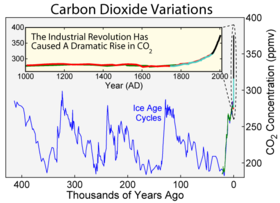
The climate system varies through natural, internal processes and in response to variations in external "forcing" from both human and natural causes. These forcing factors include solar activity, volcanic emissions, variations in the earth's orbit ( orbital forcing) and greenhouse gases. The detailed causes of the recent warming remain an active field of research, but the scientific consensus identifies greenhouse gases as the main influence.
Contrasting with this consensus view, other hypotheses have been proposed to explain all or most of the observed increase in global temperatures, including: the warming is within the range of natural variation; the warming is a consequence of coming out of a prior cool period, namely the Little Ice Age; and the warming is primarily a result of variances in solar radiation.
Adding carbon dioxide (CO2) or methane (CH4) to Earth's atmosphere, with no other changes, will make the planet's surface warmer. Greenhouse gases create a natural greenhouse effect without which temperatures on Earth would be an estimated 30 °C (54 °F) lower, so that Earth would be uninhabitable. It is therefore not correct to say that there is a debate between those who "believe in" and "oppose" the greenhouse effect as such. Rather, the debate concerns the net effect of the addition of greenhouse gases when allowing for compounding or mitigating factors.
One example of an important feedback process is ice-albedo feedback. The increased CO2 in the atmosphere warms the Earth's surface and leads to melting of ice near the poles. As the ice melts, land or open water takes its place. Both land and open water are on average less reflective than ice, and thus absorb more solar radiation. This causes more warming, which in turn causes more melting, and this cycle continues.
Due to the thermal inertia of the Earth's oceans and slow responses of other indirect effects, the Earth's current climate is not in equilibrium with the forcing imposed by increased greenhouse gases. Climate commitment studies indicate that, even if greenhouse gases were stabilized at present day levels, a further warming of about 0.5 °C (0.9 °F) would still occur.
Greenhouse gases in the atmosphere

The greenhouse effect, first discovered by Joseph Fourier in 1824, and first investigated quantitatively by Svante Arrhenius in 1896, is the process in which the emission of infrared radiation by atmospheric gasses warms a planet's surface. On Earth, the major natural greenhouse gases are water vapor, which causes about 36-70% of the greenhouse effect ( not including clouds); carbon dioxide, which causes 9-26%; methane, which causes 4-9%, and ozone, which causes 3-7%.
The atmospheric concentrations of carbon dioxide and methane have increased by 31% and 149% respectively above pre-industrial levels since 1750. This is considerably higher than at any time during the last 650,000 years, the period for which reliable data has been extracted from ice cores. From less direct geological evidence it is believed that carbon dioxide values this high were last attained 24 million years ago. About three-quarters of the anthropogenic (man-made) emissions of carbon dioxide to the atmosphere during the past 20 years are due to fossil fuel burning. The rest of the anthropogenic emissions are predominantly due to land-use change, especially deforestation.
Future carbon dioxide levels are expected to rise due to ongoing burning of fossil fuels. The rate of rise will depend on uncertain economic, sociological, technological, natural developments, but may be ultimately limited by the availability of fossil fuels. The IPCC Special Report on Emissions Scenarios gives a wide range of future carbon dioxide scenarios, ranging from 541 to 970 parts per million by the year 2100. Fossil fuel reserves are sufficient to reach this level and continue emissions past 2100, if coal, tar sands or Methane clathrates are extensively used.
Carbon sink ecosystems (forests and oceans) are being degraded by pollutants. Degradation of major carbon sinks results in higher atmospheric carbon dioxide levels.
Positive feedback effects such as the expected release of methane from the melting of permafrost peat bogs in Siberia (possibly up to 70,000 million tonnes), may lead to significant additional sources of greenhouse gas emissions not included in IPCC's climate models.
The measure of the temperature response to increased greenhouse gas concentrations and other anthropogenic and natural climate forcings is climate sensitivity. It is found by observational and model studies. This sensitivity is usually expressed in terms of the temperature response expected from a doubling of CO2 in the atmosphere. The current literature estimates sensitivity in the range of 1.5 to 4.5 °C (2.7 to 8.1 °F).
Solar variation
Modeling studies reported in the IPCC Third Assessment Report (TAR) found that volcanic and solar forcings may account for half of the temperature variations prior to 1950, but the net effect of such natural forcings has been roughly neutral since then. The IPCC Fourth Assessment Report (AR4) gives a best estimate for radiative forcing from changes in solar activity of +0.12 watts per square meter. This is less than half of the estimate given in the TAR. For comparison, the combined effects of all human activity are estimated to be an order of magnitude greater at +1.6 watts per square meter.
In a review of existing literature, Foukal et al. (2006) determined both that the variations in solar output were too small to have contributed appreciably to global warming since the mid-1970s and that there was no evidence of a net increase in brightness during this period.
Some scientists assert that a warming of the stratosphere, which has not been observed, would be expected if there were a significant increase in solar activity.
Some researchers (e.g. Stott et al. 2003) believe that the effect of solar forcing is being underestimated and propose that solar forcing accounts for 16% or 36% of recent greenhouse warming. Others (e.g. Marsh and Svensmark 2000) have proposed that feedback from clouds or other processes enhance the direct effect of solar variation, which, if true, would also suggest that the effect of solar variability was being underestimated. In general, the IPCC describes the level of scientific understanding of the contribution of variations in solar irradiance to historical climate changes as "low."
The present level of solar activity is historically high. Solanki et al. (2004) suggest that solar activity for the last 60 to 70 years may be at its highest level in 8,000 years; Muscheler et al. disagree, suggesting that other comparably high levels of activity have occurred several times in the last few thousand years. Solanki concluded based on their analysis that there is a 92% probability that solar activity will decrease over the next 50 years. Additionally, in 2005, researchers at Duke University have found that 10–30% of the warming over the last two decades may be due to increased solar output.
Attributed and expected effects
Some effects on both the natural environment and human life are, at least in part, already being attributed to global warming. Glacier retreat, ice shelf disruption such as the Larsen Ice Shelf, sea level rise, changes in rainfall patterns, increased intensity and frequency of hurricanes and extreme weather events, are being attributed at least in part to global warming. While changes are expected for overall patterns, intensity, and frequencies, it is difficult or impossible to attribute specific events (such as Hurricane Katrina) to global warming.
Some anticipated effects include sea level rise of 110 to 770 mm (0.36 to 2.5 feet) by 2100, repercussions to agriculture, possible slowing of the thermohaline circulation, reductions in the ozone layer, increased intensity and frequency of hurricanes and extreme weather events, lowering of ocean pH, the spread of diseases such as malaria and dengue fever, and mass extinction events.
Increasing extreme weather catastrophes are due to increasing severe weather and an increase in population densities. The World Meteorological Organization and the U.S. Environmental Protection Agency have linked increasing extreme weather events to global warming, as have Hoyos et al. (2006), writing that the increasing number of category 4 and 5 hurricanes is directly linked to increasing temperatures. Similarly, Kerry Emmanuel in Nature writes that hurricane power dissipation is highly correlated with temperature, reflecting global warming. Hurricane modeling has produced similar results, finding that hurricanes, simulated under warmer, high-CO2 conditions, are more intense than under present-day conditions. NOAA claims that warming induced by greenhouse gas may lead to increasing occurrence of highly destructive category-5 storms.
Mitigation
The broad agreement among climate scientists that global temperatures will continue to increase has led nations, states, corporations and individuals to implement actions to try to curtail global warming. Some of the strategies that have been proposed for mitigation of global warming include development of new technologies; carbon offsets; renewable energy such as wind power, and solar power; nuclear power; electric or plug-in hybrid electric vehicles; non-fossil fuel cells; energy conservation; carbon taxes; improving natural carbon dioxide sinks; deliberate production of sulfate aerosols, which produce a cooling effect on the Earth; population control; carbon capture and storage; and nanotechnology. Many environmental groups encourage individual action against global warming, often aimed at the consumer, and there has been business action on climate change.
Kyoto Protocol
The world's primary international agreement on combating global warming is the Kyoto Protocol. The Kyoto Protocol is an amendment to the United Nations Framework Convention on Climate Change (UNFCCC). Countries that ratify this protocol commit to reduce their emissions of carbon dioxide and five other greenhouse gases, or engage in emissions trading if they maintain or increase emissions of these gases. Developing countries are exempt from meeting emission standards in Kyoto. This includes China and India, the second and third largest emitters of CO2, behind the United States.
Climate models
Scientists have studied global warming with computer models of the climate. These models predict that the net effect of adding greenhouse gases will be a warmer climate in the future. However, even when the same assumptions of fossil fuel consumption and CO2 emission are used, the amount of predicted warming varies between models and there still remains a considerable range of climate sensitivity.
Including model and future greenhouse gas uncertainty, the IPCC anticipates a warming of 1.1 °C to 6.4 °C (2.0 °F to 11.5 °F) between 1990 and 2100. They have also been used to help investigate the causes of recent climate change by comparing the observed changes to those that the models predict from various natural and human derived forcing factors.
Climate models can produce a good match to observations of global temperature changes over the last century. These models do not unambiguously attribute the warming that occurred from approximately 1910 to 1945 to either natural variation or human effects; however, they suggest that the warming since 1975 is dominated by man-made greenhouse gas emissions.
Most global climate models, when run to predict future climate, are forced by imposed greenhouse gas scenarios, generally one from the IPCC Special Report on Emissions Scenarios (SRES). Less commonly, models may be run by adding a simulation of the carbon cycle; this generally shows a positive feedback, though this response is uncertain (under the A2 SRES scenario, responses vary between an extra 20 and 200 ppm of CO2). Some observational studies also show a positive feedback.
The representation of clouds is one of the main sources of uncertainty in present-generation models, though progress is being made on this problem. There is also an ongoing discussion as to whether climate models are neglecting important indirect and feedback effects of solar variability.
Other related issues
Ocean acidification
Increased atmospheric carbon dioxide increases the amount of CO2 dissolved in the oceans. Carbon dioxide gas dissolved in the ocean reacts with water to form carbonic acid resulting in ocean acidification. Since biosystems are adapted to a narrow range of pH, this is a serious concern directly driven by increased atmospheric CO2 and not global warming.
Relationship to ozone depletion
Although they are often interlinked in the mass media, the connection between global warming and ozone depletion is not strong. There are five areas of linkage:
- The same carbon dioxide radiative forcing that produces near-surface global warming is expected (perhaps somewhat surprisingly) to cool the stratosphere. This, in turn, would lead to a relative increase in ozone depletion and the frequency of ozone holes.
- Conversely, ozone depletion represents a radiative forcing of the climate system. There are two opposed effects: Reduced ozone allows more solar radiation to penetrate, thus warming the troposphere instead of the stratosphere; the resulting colder stratosphere emits less long-wave radiation down to the troposphere, thus having a cooling effect. Overall, the cooling dominates; the IPCC concludes that "observed stratospheric O3 losses over the past two decades have caused a negative forcing of the surface-troposphere system" of about −0.15 ± 0.10 W/m2.
- One of the strongest predictions of the greenhouse effect theory is that the stratosphere will cool. Although this cooling has been observed, it is not trivial to separate the effects of changes in the concentration of greenhouse gases and ozone depletion since both will lead to cooling. However, this can be done by numerical stratospheric modeling. Results from the National Oceanic and Atmospheric Administration's Geophysical Fluid Dynamics Laboratory show that above 20 km (12.4 miles), the greenhouse gases dominate the cooling.
- Ozone depleting chemicals are also greenhouse gases, representing 0.34 ± 0.03 W/m2, or about 14% of the total radiative forcing from well-mixed greenhouse gases.
Relationship to global dimming
Scientists have stated with 66-90% confidence that the effects of volcanic and human-caused aerosols have offset some of global warming, and that greenhouse gases would have resulted in more warming than observed if not for this effect.
- For comparison of the relative significance of these factors:
- The best estimate for the magnitude of radiative forcing from the long-lived greenhouse gases CO2, CH4, and N2O alone is +2.3 watts/m2.
- Radiative forcing from the halocarbon class of long-lived greenhouse gases is about +0.34 watts/m2.
- The cooling effects of aerosols are estimated to be:
- Direct cooling effects of -0.5 watts/m2
- Cloud albedo cooling effects of -0.7 watts/m2
- Total warming effects from post-industrial human activity including the above and other cooling and warming factors are estimated at +1.6 watts/m2.
Pre-human global warming
The earth has experienced natural global warming and cooling many times in the past. The recent Antarctic EPICA ice core spans 800,000 years, including eight glacial cycles with interglacial warming periods much hotter than current temperatures. The chart also shows the time of the last glacial maximum about 20,000 years ago.
It is thought by some geologists that a rapid buildup of greenhouse gases caused the Earth to experience global warming in the early Jurassic period, with average temperatures rising by 5 °C (9.0 °F). Research by the Open University indicates that this caused the rate of rock weathering to increase by 400%. As such weathering locks away carbon in calcite and dolomite, carbon dioxide levels dropped back to normal over roughly the next 150,000 years.
Sudden releases of methane from clathrate compounds (the Clathrate Gun Hypothesis) have been hypothesized as a cause for other past global warming events, including the Permian-Triassic extinction event and the Paleocene-Eocene Thermal Maximum. However, warming at the end of the last glacial period is thought not to be due to methane release. Instead, natural variations in the Earth's orbit ( Milankovitch cycles) are believed to have triggered the retreat of ice sheets by changing the amount of solar radiation received at high latitude and led to deglaciation.
Using paleoclimate data for the last 500 million years Veizer et al. (2000, Nature 408, pp. 698–701) concluded that long-term temperature variations are only weakly related to carbon dioxide variations. Most paleoclimatologists believe this is because other factors, such as continental drift and mountain building have larger effects in determining very long-term climate. However, Shaviv and Veizer (2003) proposed that the biggest long-term influence on temperature is actually the solar system's motion around the galaxy, and the ways in which this influences the atmosphere by altering the flux of cosmic rays received by the Earth. Afterwards, they argued that over geologic times a change in carbon dioxide concentrations comparable to doubling pre-industrial levels, only results in about 0.75 °C (1.35 °F) warming rather than the usual 1.5–4.5 °C (2.7–8.1 °F) reported by climate models. They acknowledge (Shaviv and Veizer 2004) however that this conclusion may only be valid on multi-million year time scales when glacial and geological feedback have had a chance to establish themselves. Rahmstorf et al. argue that Shaviv and Veizer arbitrarily tuned their data, and that their conclusions are unreliable.
Pre-industrial global warming
Paleoclimatologist William Ruddiman has argued that human influence on the global climate began around 8,000 years ago with the start of forest clearing to provide land for agriculture and 5,000 years ago with the start of Asian rice irrigation. He contends that forest clearing explains the rise in carbon dioxide levels in the current interglacial that started 8,000 years ago, contrasting with the decline in carbon dioxide levels seen in the previous three interglacials. He further contends that the spread of rice irrigation explains the breakdown in the last 5,000 years of the correlation between the Northern Hemisphere solar radiation and global methane levels, which had been maintained over at least the last eleven 22,000-year cycles. Ruddiman argues that without these effects, the Earth would be nearly 2 °C (3.6 °F) cooler and "well on the way" to a new ice age. Ruddiman's interpretation of the historical record, with respect to the methane data, has been disputed.
